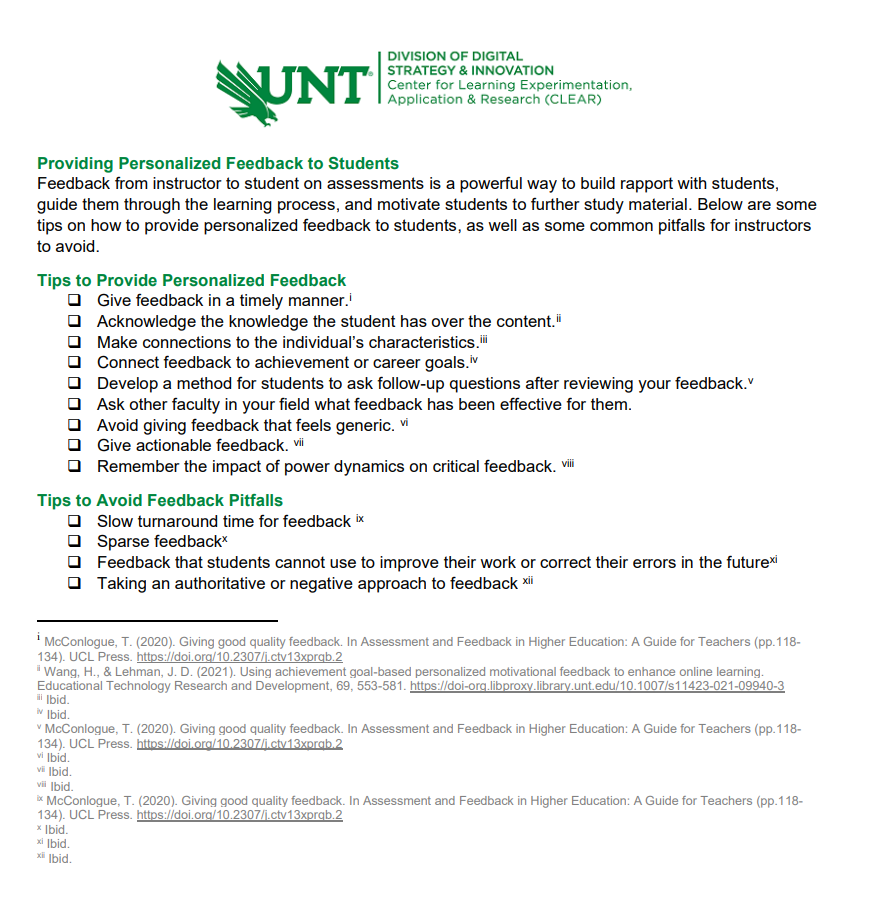Tips for Providing Personalized Feedback to Students
- DSI CLEAR
- Teaching Resources
- Theory & Practice
- Methods for Continuous Improvement
- Using AI in the Higher Education Classroom
- Invisible Labor and Faculty Retention Since COVID-19
- Inclusive Discussions
- Inclusive Assessment
- Designing Assessments for Academic Integrity
- Inclusive Instructional Strategies
- Instructor Presence in the Online Classroom
- Tips for Providing Personalized Feedback to Students
- Course Design for Student Retention
- UNT's CLAW 3 Active Learning Classroom Instructional Guide
- UNT Faculty Teaching & Learning Resource Guide
- Growth Mindset in the Higher Education Classroom
- Course Outcomes & Objectives
- Multimedia Course Design for Student Engagement and Retention
- Level Up Learning With Portfolios
- Group Work in Higher Education: Benefits & Practices for Success
- Open Educational Resources & Copyright Essentials for Instructors
- Evaluating OER Resources
- Accessibility Online
- Copyright Guide
- Online Teaching
- UNT Syllabus Template
- Teaching Consultation Request
- Open Educational Resources & Copyright Essentials for Instructors
- Evaluating OER Resources
Tips for Providing Personalized Feedback to Students

Providing feedback to students allows instructors to establish presence in the course and facilitate a natural channel for interaction. Feedback is also a way for instructors to track students’ understanding of material and help guide the learning process. This article provides tips from recent literature on using personalized feedback.
Personalized Feedback
The goals of personalized feedback, sometimes referred to as individualized feedback, are to:
- connect with students,
- help students understand course content, and
- motivate students to study future material.
Providing feedback based on students’ achievement goals and learner characteristics, in tandem with standard cognitive-level feedback, can help increase student motivation and self-regulation (Wang & Lehman, 2021). Instructors can personalize feedback by tailoring messages to individual learner characteristics such as content knowledge, metacognitive skills, and self-confidence (Wang & Lehman, 2021). Feedback can also serve as a space for dialogue to occur where students can discuss and clarify the feedback they receive (McConlogue, 2020).
Students from different disciplines may require different types of feedback. For example, language learners tend to benefit more from direct error-focused feedback such as feedback on grammar, organizing, and their ideas (Ganapathy et al., 2020). Students from underrepresented or marginalized groups who struggle transitioning to college may especially benefit from consistent personalized feedback in their first year of college (Espinoza & Genna, 2021).
The following approaches can help faculty provide personalized feedback that improves student performance:
- Give timely feedback (McConlogue, 2020).
- Mention student content knowledge (Wang & Lehman, 2021).
- Make connections to individual characteristics (Wang & Lehman, 2021).
- Connect feedback to achievement or career goals (Wang & Lehman, 2021).
- Develop a method for students to ask follow-up questions (McConlogue, 2020).
- Ask other faculty in your field what feedback has been effective.
- Avoid giving feedback that feels generic (McConlogue, 2020).
- Give actionable feedback (McConlogue, 2020).
- Remember the impact of power dynamics on critical feedback (McConlogue, 2020).
Feedback Pitfalls to Avoid
According to a recent study by Wang and Lehman (2021), while student motivation and self-regulation improved as a result of personalized feedback, performance did not. It is also important to keep in mind that beyond content, the timing, quality, and usability of feedback are important to students, and slow turnaround times and little or generic feedback can lead to student dissatisfaction (McConlogue, 2020). In addition, power dynamics between faculty and students can influence how feedback is received. Instructors who are perceived as authoritative or give negative criticism can demotivate students (McConlogue, 2020).
Overall, personalized feedback has many benefits and can provide an additional way to build relationships with students, which can help improve retention. DSI CLEAR’s faculty development unit invites you to try one or two of these feedback approaches and let us know how they work in your UNT classes.
References
Espinoza, P., & Genna, G. M. (2021). Hi, I want to talk to you about your progress: A large course intervention for at-risk college students. Journal of College Student Retention: Research, Theory & Practice, 23(1), 2-27. https://doi.org/10.1177/1521025118790054
Ganapathy, M., Tan, D. A. L., & Phan, J. (2020). Students’ perceptions of teachers’ written corrective feedback in the Malaysian ESL classroom. Malaysian Journal of Learning and Instruction, 17(2), 103-136.
Lim, L., Dawson, S., Gašević, D., Joksimović, S., Pardo, A., Fudge, A., &Gentili, S. (2021). Students’ perceptions of, and emotional responses to, personalised learning analytics-based feedback: an exploratory study of four courses. Assessment & Evaluation in Higher Education, 46(3), 339-359. https://doi.org/10.1080/02602938.2020.1782831
McConlogue, T. (2020). Giving good quality feedback. In Assessment and Feedback in Higher Education: A Guide for Teachers (pp.118-134). UCL Press. https://doi.org/10.2307/j.ctv13xprqb.2
Wang, H., & Lehman, J. D. (2021). Using achievement goal-based personalized motivational feedback to enhance online learning. Educational Technology Research and Development, 69, 553-581. https://doi-org.libproxy.library.unt.edu/10.1007/s11423-021-09940-3
Yilmaz, F. G. K., & Yilmaz, R. (2020). Student opinions about personalized recommendation and feedback based on learning analytics. Technology, Knowledge and Learning, 25, 753-768. https://doi.org/10.1007/s10758-020-09460-8
